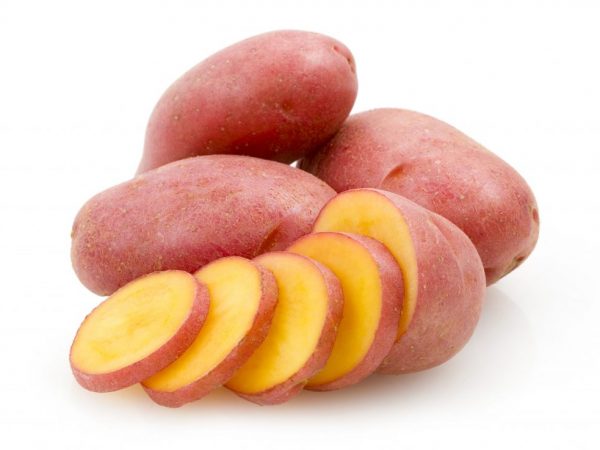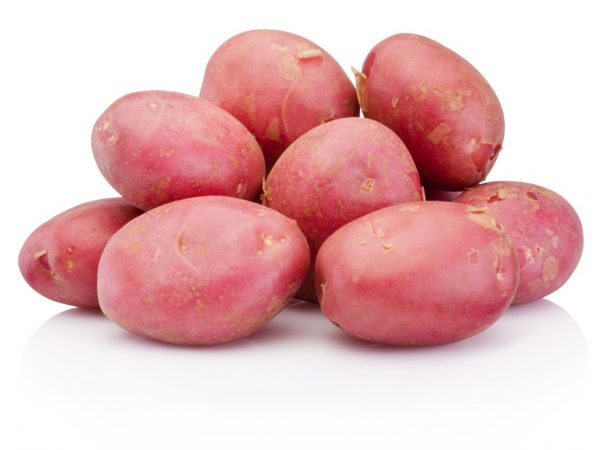Description of Rodrigo potatoes
Rodrigo's potatoes have long taken root in our favorite dishes. Due to its many advantages, it is grown both for personal consumption and on an industrial scale.

Description of Rodrigo potatoes
Characteristics
The description of the potato variety Rodrigo indicates that this is a culture that is used to prepare first and second courses. The qualitative characteristic suggests that the potato is suitable for growing in any region - this favorably emphasizes its advantages.
Varietal properties
If we take the description of the Rodrigo potato variety, it can be noted that it is early or mid-season, its ripening period is 80 days.
The qualitative characteristic suggests that the Rodrigo potato variety is the best choice for planting among experienced farmers. Delicious, boiling pulp is perfect for lovers of delicious vegetable dishes.
Choosing Rodrigo potatoes for planting, you will not regret: high yields will not only allow you to make supplies for the winter, but also sell vegetables at a profit on the market.
Description of the fetus
- The shape of the potato is oval, some elongation is possible.
- The color of the peel is pink, the soft part is yellow.
- The weight of one vegetable is from 300 to 700 gr.
The peel of a vegetable, ready to eat, should be: thin, easily peeled off. Ripe fruits are characterized by a dense, dark pink skin. Rodrigo's potatoes reach their conditional ripeness much faster than technical ones. This means that vegetables grow to the required size much faster than the peel hardens.
Bush characteristic
- The bushes are very tall and reach lengths of up to 1.2 meters, in their scale they are extensive, spreading.
- Leaves are medium, dark green in color.
- Blooms in a month and a half from planting, purple-red flowers.
- Flammability from one bush ranges from 7 to 9 fruits.
Advantages
The description of the advantages of such a vegetable among farmers suggests that the Rodrigo potato variety is ideal for planting in arid regions of the country. Due to the wide growth of the bush, the plant is able to create a shade for itself, which allows it to retain moisture longer. High yield, good transportability, knowing these qualities of the fruit, you can be sure about your harvest. According to statistics, a vegetable crop every year gives good shoots, and subsequently a rich collection of products.
Due to its resistance to many climatic conditions, the vegetable is grown in all parts of the country. The bush is not whimsical to care for and does not require planting in a special soil, which is especially valuable for breeders who are trying to pick up a fruitful, but the most unpretentious variety for planting.
The characteristic shows that the potato variety Rodrigos is immune to a variety of diseases. They endure insect invasions. Has a high degree of keeping quality, with long-term storage in basements, product losses will be only 3-5%.Another advantage of vegetable crops is the high starch content of 15 to 20%. As revealed, Rodriguez has no flaws. The qualitative characteristic speaks for itself.
Product application

Potatoes are used in various fields
Potatoes have a wide range of uses, one has only to remember the dishes that can be prepared from a vegetable. Various salads, soups and casseroles, vegetable culture will suit any kitchen.
Everyone knows about the beneficial properties of potatoes, it is rich in vitamins B, C, PP, and also contains potassium and phosphorus. It is widely used in treatments in folk medicine and cosmetology. Vegetable masks - rejuvenate and give shine to the skin of the face.
Rodrigo's potatoes are used to make chips in factories. Also, starch is isolated from the vegetable, which has a wide range of uses: as a thickener, in the food industry, is also used in paper mills and is part of the product.
Growing yourself
Seed potatoes should be prepared in advance, about a week before planting. The tubers must be removed from the basement and placed in a warm place, thereby allowing the sprouts to develop. Disembarkation begins in late April or early May, you should take into account the weather for the near future after landing in order to avoid the effects of frost.
On the selected area for planting, first, carry out aeration of the soil in order to enrich it with oxygen for future sowing. We will season the potatoes with Rodrigo with manure, right into the hole along with the tuber. To do this, we dig a groove for planting, fill in a small part of the fertilizer and put the potatoes sprouted up. Next, carefully fill it with earth and make a small elevation from the soil, thereby marking the landing site. Taking into account the growth and development of the bush, Rodrigo's potatoes should be planted according to the 25 × 60 scheme, and the distance between the rows should be at least 50 cm.
In order to avoid the influence of frost on the future harvest, the sown vegetables should be covered with foil until the first shoots appear. Such actions will accelerate the development of the shoots and provide thermal insulation.
Disease prevention
Like any other crop, potatoes are susceptible to various diseases and pests. One of the most harmful diseases of a vegetable is late blight, which provokes a fungus. If preventive measures are not taken, then the yield loss can reach more than 50%. Fungi actively multiply with prolonged dampness, infecting the soil and tubers. In preventive measures, you should choose resistant varieties of vegetables, germinate sprouts in advance. Fertilize the soil with a solution of copper sulfate with lime.
Potato cancer is a disease that affects tubers, forms growths in the places of the potato peephole. At first, the increments are small, but as the fetus grows, the disease progresses, and the increments increase and harden. If your crop was struck by a disease such as cancer, then tuberous plants should not be planted at the planting site for the next 3 years.
A disease called Alternaria is also dangerous and can spoil up to 40% of your vegetable harvest. It begins on the leaves of a bush in the form of brown spots. Most often, the disease affects the bush before flowering, the leaves become stained, and then die off. A disease similar in etymology, Phimosis, affects the stems of the bush, manifesting itself in the form of spots. After harvesting, dents appear on the fruit, which fester.
In order to avoid diseases such as Phimosis and Brown Spot, you should sprinkle the soil with calcium, and also monitor the correct storage of vegetables for planting.
Pest control methods
Colorado beetle is one of the most dangerous pests of vegetable crops. The beetle eats leaves, stems and tubers. In search of food, such a pest can travel very long distances. The insect multiplies quickly, therefore, insecticides and manual collection of insects and its offspring are used in the fight against it.
Wireworms or darkling beetle larvae eat tubers and bush stems. The larvae cause irreparable harm to the plant, leading to the drying out and wilting of the bush. The most effective method of control is the early planting of vegetables, adherence to the rules for storing tubers for planting.
Medvedka is a large insect that feeds on tubers, gnawing huge holes in them, which leads to decay and loss of yield. In the fight against a pest, it is possible to use a vinegar solution.


